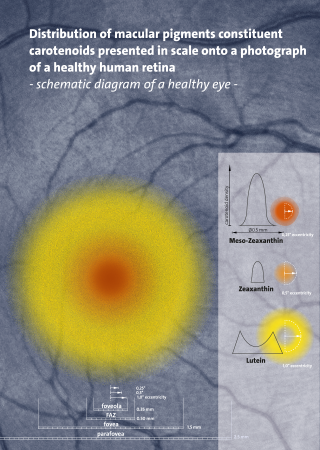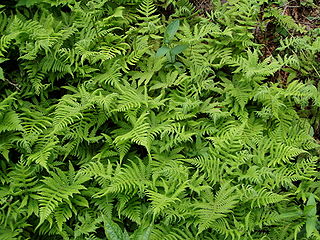
Carotenoids are yellow, orange, and red organic pigments that are produced by plants and algae, as well as several bacteria, archaea, and fungi. Carotenoids give the characteristic color to pumpkins, carrots, parsnips, corn, tomatoes, canaries, flamingos, salmon, lobster, shrimp, and daffodils. Over 1,100 identified carotenoids can be further categorized into two classes – xanthophylls and carotenes.

Toxicodendron vernix, commonly known as poison sumac, or swamp-sumach, is a woody shrub or small tree growing to 9 metres (30 feet) tall. It was previously known as Rhus vernix. This plant is also known as thunderwood, particularly where it occurs in the southern United States. All parts of the plant contain a resin called urushiol that causes skin and mucous membrane irritation to humans. Urushiol is the same chemical that poison ivy is covered in. When the plant is burned, inhalation of the smoke may cause the rash to appear on the lining of the lungs, causing extreme pain and possibly fatal respiratory difficulty.
Squaric acid, also called quadratic acid because its four carbon atoms approximately form a square, is a diprotic organic acid with the chemical formula C4O2(OH)2.

Rhizophora is a genus of tropical mangrove trees, sometimes collectively called true mangroves. The most notable species is the red mangrove but some other species and a few natural hybrids are known. Rhizophora species generally live in intertidal zones which are inundated daily by the ocean. They exhibit a number of adaptations to this environment, including pneumatophores that elevate the plants above the water and allow them to respire oxygen even while their lower roots are submerged and a cytological molecular "pump" mechanism that allows them to remove excess salts from their cells. The generic name is derived from the Greek words ριζα (rhiza), meaning "root," and φορος (phoros), meaning "bearing," referring to the stilt-roots.

Barringtonia acutangula is a species of Barringtonia native to coastal wetlands in southern Asia and northern Australasia, from Afghanistan east to the Philippines, Queensland and the Northern Territory. Common names include freshwater mangrove, itchytree and mango-pine.

DIMBOA (2,4-dihydroxy-7-methoxy-1,4-benzoxazin-3-one) is a naturally occurring hydroxamic acid, a benzoxazinoid. DIMBOA is a powerful antibiotic present in maize, wheat, rye, and related grasses,

Aegiceras is a genus of trees and shrubs from Southeast Asia, Malesia, Australia and the Pacific Island,. and in Australia, in the Northern Territory, Queensland, New South Wales, and Western Australia. They occur as mangroves in coastal or estuarine areas.

Phegopteris connectilis, commonly known as long beech fern, northern beech fern, and narrow beech fern, is a species of clonal fern native to forests of the Northern Hemisphere.

Crateva is a genus of flowering plants in the caper family, Capparaceae. It includes 21 species which range through the tropical regions of the world, including the tropical Americas, sub-Saharan Africa, the Indian subcontinent, Indochina, southern China, Japan, Malesia, Papuasia, Queensland, and the South Pacific.
2,4,7-trihydroxy-1,4-benzoxazin-3-one-glucoside 7-O-methyltransferase is an enzyme with systematic name S-adenosyl-L-methionine:(2R)-4,7-dihydroxy-3-oxo-3,4-dihydro-2H-1,4-benzoxazin-2-yl β-D-glucopyranoside 7-O-methyltransferase. This enzyme catalyses the following chemical reaction
2,4-Dihydroxy-7-methoxy-2H-1,4-benzoxazin-3(4H)-one 2-D-glucosyltransferase is an enzyme with systematic name UDP-alpha-D-glucose:2,4-dihydroxy-7-methoxy-2H-1,4-benzoxazin-3(4H)-one 2-beta-D-glucosyltransferase. This enzyme catalyses the following chemical reaction
4-Hydroxy-7-methoxy-3-oxo-3,4-dihydro-2H-1,4-benzoxazin-2-yl glucoside beta-D-glucosidase (EC 3.2.1.182, DIMBOAGlc hydrolase, DIMBOA glucosidase) is an enzyme with systematic name (2R)-4-hydroxy-7-methoxy-3-oxo-3,4-dihydro-2H-1,4-benzoxazin-2-yl beta-D-glucopyranoside beta-D-glucosidase. This enzyme catalyses the following chemical reaction

Homoisoflavonoids (3-benzylidenechroman-4-ones) are a type of phenolic compounds occurring naturally in plants.

Hakea nitida, commonly called the frog hakea or shining hakea, is a shrub of the family Proteaceae and is endemic to an area in the southern Wheatbelt, Great Southern and Goldfields-Esperance regions of Western Australia.
Amnibacterium endophyticum is a Gram-positive, aerobic, non-spore-forming, short rod-shaped and non-motile bacterium from the genus of Amnibacterium which has been isolated from a branch of the tree Aegiceras corniculatum.
Aureimonas endophytica is a Gram-negative, aerobic, coccoid rod-shaped and motile bacteria from the genus of Aurantimonas which has been isolated from the plant Aegiceras corniculatum from the Cotai Ecological Zones in China.

Garcinia pseudoguttifera, known as the mo'onia tree in its native range, is a species of flowering tree in the family Clusiaceae (Guttiferae). The specific epithet (pseudoguttifera) comes from Greek pseudo and Neo-Latin guttifera.
Embelia schimperi is a shrubby climber or small tree within the family Primulaceae.













